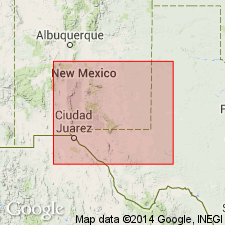
- Usage in publication:
-
- Three Twins member
- Modifications:
-
- Original reference
- Dominant lithology:
-
- Sandstone
- Sand
- Redbeds
- Anhydrite
- Shale
- Limestone
- AAPG geologic province:
-
- Permian basin
Summary:
Three Twins member of Chalk Bluff formation. North from Little McKittrick to Spencer Draw the top of the Carlsbad limestone grades into sandstones, which in turn are in part displaced by anhydritic sands, sandy red beds, anhydrites, fine greenish sandstones, thin greenish-gray sandy shales and dolomitic limestones. This sequence of beds is here named Three Twins member of Chalk Bluff formation, from Three Twins Hills, Pecos Valley, Eddy Co., southeastern NM, where, in Spencer Draw, a partial section is exposed. This member is top part of the formation. It is underlain by Azotea tongue of Carlsbad limestone, or, where that is absent, by lithologically similar Seven Rivers member. The Three Twins and Seven Rivers members represent greater part of Chalk Bluff formation and are = Carlsbad and Capitan limestones of reef zone. Age is Permian.
Source: US geologic names lexicon (USGS Bull. 896, p. 2144).
For more information, please contact Nancy Stamm, Geologic Names Committee Secretary.
Asterisk (*) indicates published by U.S. Geological Survey authors.
"No current usage" (†) implies that a name has been abandoned or has fallen into disuse. Former usage and, if known, replacement name given in parentheses ( ).
Slash (/) indicates name conflicts with nomenclatural guidelines (CSN, 1933; ACSN, 1961, 1970; NACSN, 1983, 2005, 2021). May be explained within brackets ([ ]).

